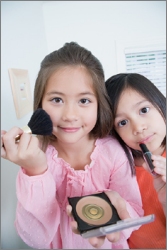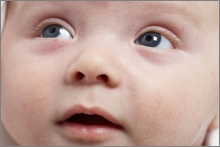Why Prescription Drugs, Household Cleaners and More
Are Still Enemy #1 for Children and Pets
(and How to Prevent a Disaster in Your Home)
by www.SixWise.com
Your home is a safe haven to relax in and enjoy the company of those you love. But it is in this protected environment that exists one of the top dangers to children, pets and adults' health: poisoning.
Almost all possible poisonings (93 percent) happen at home, according to the American Association of Poison Control Centers, and 51 percent of them involve children under age 6.
|

The most common forms of poison exposure for children under age 6 are cosmetics and personal care products (13.4%), cleaning substances (9.8%), pain medication (8.2%) and foreign bodies (7.4%), according to the American Association of Poison Control Centers.
|
Though you may think an accidental poisoning won't happen in your home, one only has to peruse the chemicals under their kitchen sink, in their garage and in their medicine cabinet to get an idea of how pervasive potential poisons are in our homes.
More than 2 million possible poisonings are reported to U.S. poison centers every year, with one call coming in every 13 seconds. And although children are often involved, this is an adult problem too -- more than 70 percent of all poison deaths occur in adults ages 20 to 59!
More than 1,220 people died from poisoning in 2006 (the most recent year that data is available), over 2% of which were children under 6.
What are the Most Common Poisons?
Most poisonings involve everyday household items such as medicines, cleaning supplies, cosmetics and personal care items, so not surprisingly household items overwhelmingly top the list of poisonous substances, compiled by the American Association of Poison Control Centers (AAPCC). How many of these can you spot in your home?
Most common poisons among children:
-
cosmetics and personal care products
-
cleaning substances
-
pain medicine/fever-reducers
-
coins, thermometers
-
plants
-
diaper care, acne preparations, antiseptics
-
cough and cold preparations
-
pesticides
-
vitamins
-
gastrointestinal preparations
-
antimicrobials
-
arts, crafts and office supplies
-
antihistamines
-
hormones and hormone antagonists (diabetes medications, contraceptives)
-
hydrocarbons (lamp oil, kerosene, gasoline, lighter fluid)
Most common poisons among adults:
-
pain medicine
-
sedatives, hypnotics, antipsychotics
-
cleaning substances
-
antidepressants
-
bites and envenomations
-
alcohols
-
food products and food poisoning
-
cosmetics and personal care products
-
chemicals
-
pesticides
-
cardiovascular drugs
-
fumes, gases, vapors
-
hydrocarbons
-
antihistamines
-
anticonvulsants
-
antimicrobials
-
stimulants and street drugs
-
plants
-
cough and cold preparations
While any one of these substances can cause serious harm, the most dangerous poisons for children include, according to AAPCC:
-
Medications: If children take the wrong medicine or swallow too much it can lead to a serious reaction.
-
Iron pills: If a child swallows and adult-strength iron pill he can begin vomiting blood and having bloody diarrhea in less than an hour.
|
America's poison centers are open 24 hours a day, seven days a week to help you. If you think you or your child may have been exposed to a poison, call the Poison Help hotline 1-800-222-1222 immediately!
The Poison Help Hotline:
1-800-222-1222
|
-
Cleaning products: Drain openers, toilet bowl cleaners, rust removers and oven cleaners can cause chemical burns that are just as bad as burns from a fire.
-
Nail glue remover and nail primer for artificial nails: Nail glue removers have caused cyanide poisoning when swallowed by children, while nail primers can burn the skin.
-
Hydrocarbons: If swallowed, hydrocarbons such as gasoline, kerosene, lamp oil, motor oil, lighter fluid, furniture polish, and paint thinner can enter the lungs, making it hard to breathe and leading to lung inflammation (pneumonia). Hydrocarbons are one of the leading causes of poisoning deaths in children.
-
Pesticides: Pesticides can be absorbed through the skin or inhaled, causes difficulty breathing and damage to the nervous system.
-
Windshield washer solution and antifreeze: Windshield washer solution can cause blindness and death if swallowed, while antifreeze can cause kidney failure and death. Small amounts can be extremely poisonous to children and pets.
-
Wild mushrooms: Some wild mushrooms are deadly if eaten.
-
Alcohol: Alcohol can cause children to have seizures, go into a coma or even die. Alcoholic beverages are a concern, as is the alcohol contained in mouthwash, facial cleansers and hair tonics.
|

Signs That Your Child May Have Swallowed a Poison:
- Severe throat pain
- Breathing difficulty
- Sudden behavior changes, such as unusual sleepiness, irritability or jumpiness
- Unexplained nausea or vomiting
- Stomach cramps without fever
- Burns on your child's lips or mouth
- Unusual drooling, or odd odors on your child's breath
- Unexplained stains on your child's clothing
- Convulsions or unconsciousness (only in very serious cases)
|
How to Poison-Proof Your Home
-
Keep all cosmetics and personal care products in cabinets that children cannot reach or are locked with child-proof closures. (You can get a secure, no-hassle cabinet lock for just $3.99)
- Always keep cleansers out of the reach of children. You can also quit using them altogether if you opt to clean your house with PerfectClean terry wipes and mops, whose ultramicrofiber construction enables the clothes, mops and dusters to reach deep into microscopic crevices (NO other cleaning tool available even comes close!) and remove everything in their path: all forms of dirt, dust, hair, dander, and the biological contaminants too small to see with the naked eye-without the need for chemical cleansers!
PerfectClean products are 100% safe, and are meant to be used dry or dampened with some water, which is ideal for homes with small children or pets where poisoning is a major concern.
-
If you take a medication, always be sure to take out only your necessary dose and then put the rest in a secure location. The medicine cabinet is one of the worst places because children can easily climb up to them via the sink and open the door. At the very least, make sure your medicine cabinet is secured with a cabinet lock.
-
Don't rely on child-proof medication containers. Studies have found that children can invariably get them open if given enough time.
-
Over-the-counter (OTC) pain relievers can also be dangerous. Never give your child any medication, even if it's OTC, that is not specifically approved to be safe for children. Even then, be careful not to go over the recommended dosage.
-
Keep all pesticides, creams, ointments and preparations, even those that you use on your child like diaper cream, in an out-of-reach, locked or child-proofed cabinet.
-
Make sure coins, thermometers, plants and other potentially dangerous items are kept out of the reach of children and pets.
-
Avoid cough and cold medicines in young children. Due to safety and effectiveness concerns, the U.S. Food and Drug Administration recently advised that children under 2 should not be given such medications. They are also considering a ban on cough and cold medications for children under 6, and some experts have said the drugs do not work in children under age 12.
-
If you do give your child cough or cold medicine, be sure that you are using the proper dose, and that another adult has not already given some to the child. If used incorrectly, cough and cold medications may cause agitation or drowsiness, and in large doses may effect blood pressure and heart rhythm.
-
Treat all vitamins and supplements like drugs and keep them out of your child's reach. And never give your child vitamins meant for adults.
Recommended Reading
The Ten Most Common Poisons Among Kids
The Top Household Dangers to Your Pets
Sources
Poisonhelp.hrsa.gov
American Association of Poison Control Centers
www.1-800-222-1222.info